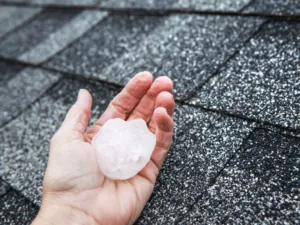
Monday to Friday
Drop your queries
Menu
Monday to Friday
Drop your queries
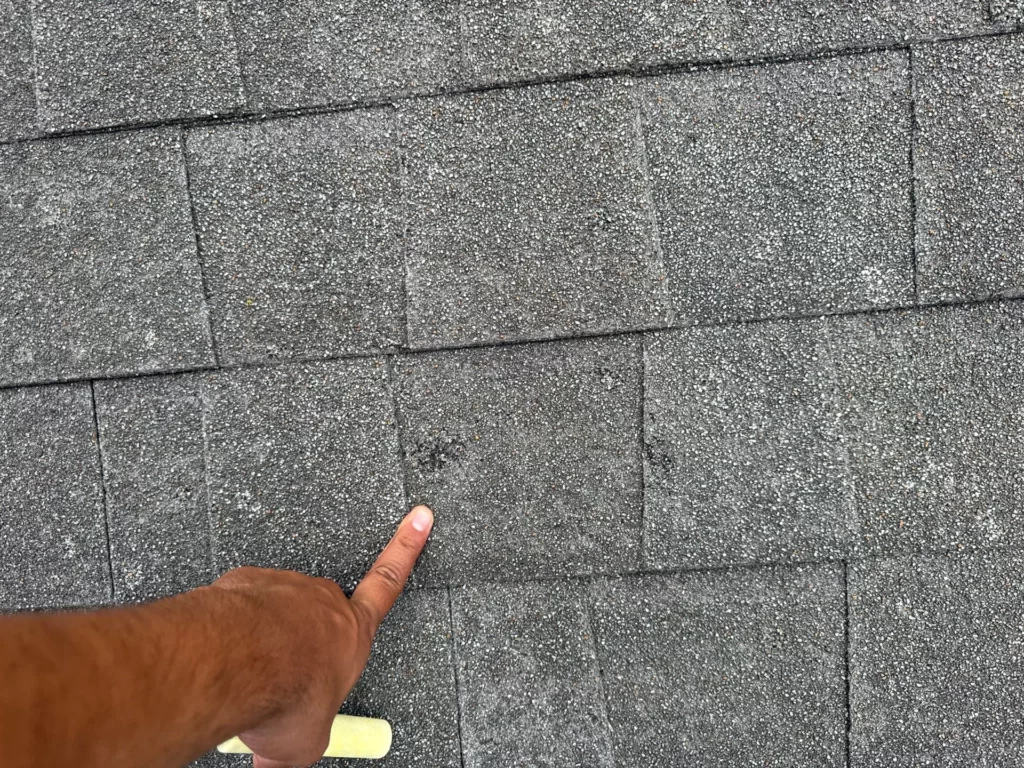
Roofing issues are common in Texas due to the state’s weather patterns. Hail, high winds, intense summer heat, and periods of heavy rain all place constant strain on roofing systems. These conditions can cause sudden storm damage or contribute to gradual wear and tear over time.
Being able to tell the difference between the two is important for homeowners. Insurance policies typically cover sudden and accidental damage from storms, but they rarely pay for repairs that are due to normal aging. This difference can determine whether you receive help from your insurer or have to pay for repairs yourself.
Texas roofs face more weather-related stress than in many other parts of the country. Areas with regular hailstorms, high ultraviolet exposure, and strong wind events see roofing materials wear down faster. Understanding what type of damage you have puts you in a better position to protect your home and manage repair costs.
The way roof damage is classified can have a direct effect on whether repairs are covered by insurance. Storm damage, such as that caused by hail or strong winds, is often included in a homeowner’s policy. Wear and tear, which results from gradual aging, is usually excluded. This difference can decide whether you receive financial help for repairs or must cover the cost yourself.
Correctly identifying the cause of damage also influences repair or replacement decisions. A roof with storm-related damage may need urgent attention to prevent further issues, while a roof that is simply showing signs of age can often be maintained with planned repairs.
There is also the risk of disputes if the cause is not documented clearly. Insurance companies, contractors, and homeowners may not always agree on the source of the problem. Having accurate inspection records can help avoid delays and ensure repairs are addressed promptly.
Roof storm damage refers to harm caused directly by a weather event rather than normal aging or wear. This type of damage happens suddenly, often during or right after storms that involve hail, high winds, heavy rain, or debris impact.
Recent insurance and construction industry reports show that Texas ranks among the highest in the nation for storm-related roof claims, especially from hail events. Hailstones as small as one inch in diameter can bruise or fracture shingles, and larger hail can break them entirely. Wind gusts over 50 miles per hour can lift shingles, loosen flashing, and expose underlayment.
Storm damage is different from gradual deterioration because it leaves irregular patterns and specific impact points. This can include dents, cracks, torn shingles, or damage to roof accessories such as vents, flashing, and gutters. In many cases, the damage is visible from the ground, but a full inspection is often needed to identify all affected areas.
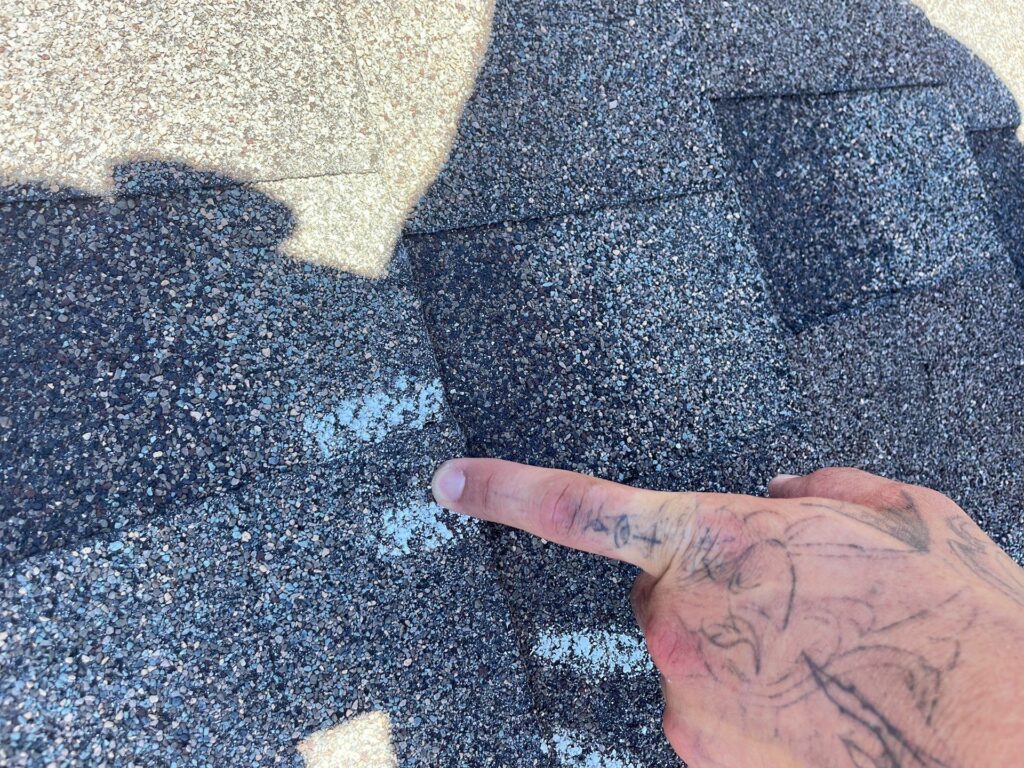
Hailstorms are one of the most common causes of sudden roof damage in Texas. Even smaller hail can leave lasting marks, while larger hailstones can break shingles completely. These are the signs that often indicate hail-related roof damage:
Bruised shingles – Soft spots that feel spongy when pressed, caused by hail impact compressing the shingle surface.
Cracked shingles – Fractures running through the shingle from direct hits.
Granule loss in circular patterns – Bare asphalt spots where hail knocked away protective granules.
Shiny or exposed asphalt – Freshly uncovered areas where granules have been removed.
Pitted or dented flashing – Small round indentations on metal flashing, vents, or chimney caps.
Damage to roof accessories – Dents in gutters, downspouts, and ridge caps that match hail size and shape.
Random distribution of marks – Unlike wear and tear, hail damage leaves irregular patterns across the roof surface.
A professional inspection can confirm whether these signs are recent and storm-related or if they are older marks from previous events. This distinction is important when preparing an insurance claim.

Strong winds can lift, loosen, or completely remove roofing materials. In Texas, wind gusts during severe storms can exceed 50 miles per hour, creating enough force to compromise even newer roofs. Common signs of wind-related damage include:
Missing shingles – Entire shingles or sections of shingles blown away, leaving the roof deck exposed.
Lifted shingle edges – Shingles that appear to be raised along the edges, often from wind breaking the adhesive seal.
Creased shingles – Horizontal lines where the shingle has been bent back and forth by wind pressure.
Exposed underlayment or nails – Areas where the roofing material has shifted enough to reveal the layers beneath.
Damaged ridge caps – Ridge shingles that are cracked, missing, or loosened by wind impact.
Loose or bent flashing – Metal strips around chimneys, vents, and valleys that have been displaced.
Debris on the roof surface – Branches, leaves, or other wind-blown materials that can scrape and weaken shingles.
Wind damage often appears in clusters along roof edges, ridges, or areas where shingles overlap. A professional inspection can determine whether these issues are recent and storm-related or if they developed over time.
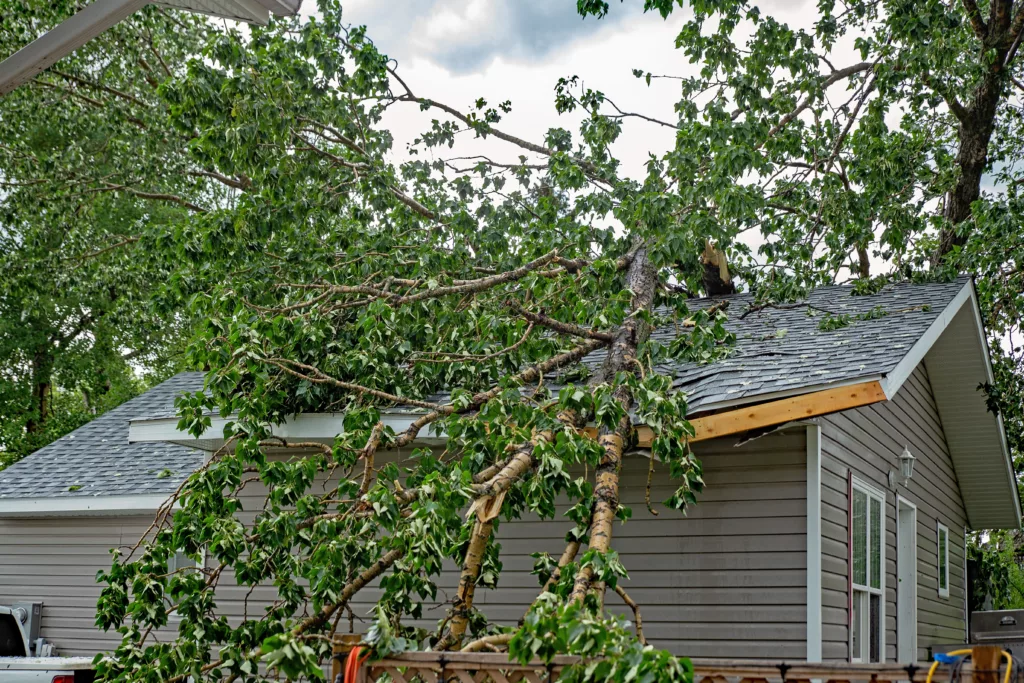
Not all roof damage comes directly from hail or wind. Severe storms can create other hazards that harm the roof and its components. Some of the most common include:
Fallen tree branches – Heavy limbs can puncture shingles, crush sections of the roof, or damage gutters and fascia.
Impact marks on flashing and vents – Debris thrown by strong winds can dent or bend metal parts, weakening their ability to keep water out.
Clogged or damaged gutters – Leaves, branches, and other debris can block drainage systems, causing water to back up under shingles.
Dislodged roof accessories – Items such as satellite dishes, solar panels, or decorative elements may loosen or break free in high winds, leaving holes or gaps.
Pooling water on flat or low-slope sections – Heavy rain can overwhelm drainage points, leading to standing water that accelerates deterioration.
While some of these issues are immediately visible, others may go unnoticed without a thorough roof inspection. Quick attention after a storm can help prevent small problems from becoming larger, more expensive repairs.
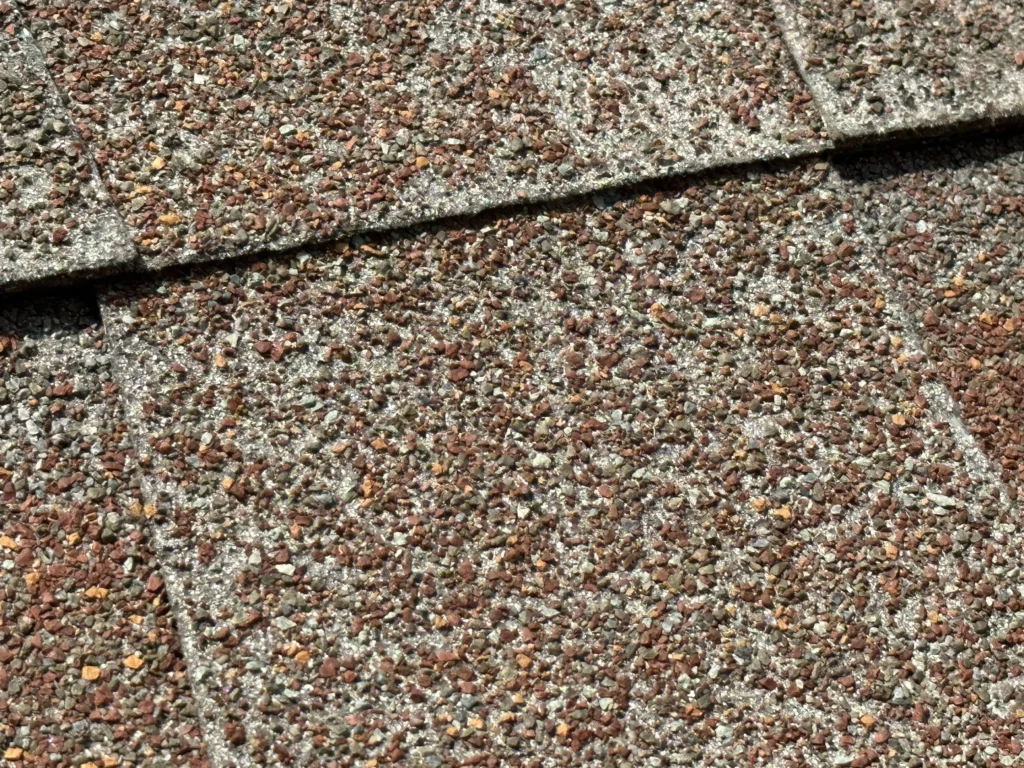
Normal wear and tear is the gradual aging and deterioration of roofing materials over time. It happens to every roof, even when installed correctly and maintained regularly. Texas weather can speed up this process because of the combination of high temperatures, intense sunlight, and seasonal storms.
Industry data shows that asphalt shingles in hot climates often age faster than in cooler regions, sometimes reaching the end of their service life several years earlier than the national average. Wear and tear is not caused by a single event but by years of exposure to sun, wind, and rain.
Common examples of wear and tear include:
Gradual shingle curling or cupping from age – Edges start to turn upward or downward due to heat cycles and material fatigue.
Uniform granule loss from long-term weather exposure – The surface becomes smoother as protective granules wear away evenly over the roof.
Minor leaks from deteriorated flashing or sealant – Materials around chimneys, vents, or valleys dry out and crack over time.
Fading or discoloration over years – Color changes caused by UV light and environmental factors.
These changes are expected as the roof ages. While they may not require immediate replacement, they can signal that the roof is getting closer to the end of its service life.
Telling the difference between storm damage and normal wear is not always easy, but there are clear signs that can help point you in the right direction.
1. Look at when the damage appeared
If you notice changes right after a storm, the damage is more likely storm-related.
If the issues have developed slowly over years, it is probably wear and tear.
2. Study the pattern of damage
Storm damage often looks random, with irregular impact marks or missing shingles in scattered areas.
Wear and tear usually affects the roof evenly, with uniform fading, granule loss, or curling.
3. Get a professional roof inspection
A trained roofing contractor can take close-up photos, check hidden areas, and determine whether the problem started suddenly or developed over time.
Certified inspections also provide the documentation needed for insurance claims and can help avoid disputes over the cause of the damage.
Knowing what to look for saves time and helps you decide whether to call your insurance company, schedule repairs, or plan for a replacement.
Homeowners often have questions about roof damage that mix personal experience, advice from neighbors, and information found online. Unfortunately, this combination can lead to misunderstandings about what qualifies as storm damage, what is considered normal wear, and what insurance will actually cover.
Misinterpretations can result in unnecessary claims, missed repair opportunities, or surprise expenses. Taking time to clarify these questions helps homeowners make informed choices, avoid disputes, and protect their investment in the roof.
Not always. A leak could be the result of older wear, previous minor damage, or poor installation. While storms can trigger leaks, the actual cause might be related to aging materials or deteriorated flashing. A professional inspection can confirm whether the leak is tied to recent weather or long-term wear.
Yes. Insurance policies typically cover sudden damage from storms, not gradual deterioration. If the adjuster determines that the problem is due to normal aging, the claim will likely be denied. Documentation from a roofing contractor can help clarify the cause before you file a claim.
Yes. Age is just one factor in roof condition. Harsh sunlight, strong winds, poor attic ventilation, or low-quality materials can cause visible wear even within the first decade.
In most cases, no. Home insurance does not pay for roof wear and tear, and it does not cover repairs for aging materials. Coverage is usually reserved for sudden events such as hailstorms, high winds, or falling objects. If the damage is due to gradual deterioration, it is considered a maintenance responsibility.
It is better to have the roof inspected first. Filing a claim for damage that turns out to be normal wear can count against your claims history. A contractor’s report will give you clarity on whether the damage is likely to be covered.
Calling a roofing professional at the right time can prevent small problems from becoming costly repairs. Texas weather can change quickly, and roofs often take the brunt of those changes.
You should reach out to a qualified roofer:
After major hail, high winds, or severe storms – Even if there is no visible damage from the ground, an inspection can uncover hidden issues.
If you notice sudden leaks – New water stains or dripping after a storm should be addressed immediately to avoid structural damage.
When shingles are visibly missing, cracked, or lifted – These signs often mean the roof is vulnerable to further damage.
Before filing an insurance claim – A detailed inspection report can help confirm whether the problem is storm-related or normal wear, which can improve the accuracy of your claim.
Legacy Roofing Pros can help by providing certified inspections, clear documentation for insurance, and repair or replacement services designed for Texas weather conditions. Having an experienced team on your side means you get honest answers and quality work that protects both your home and your budget.
Not sure if your roof has storm damage or just normal wear? A professional inspection can give you answers and help you avoid costly surprises.
Legacy Roofing Pros offers free, no-obligation roof inspections for Texas homeowners. Our certified team will document any issues, explain your options, and guide you on the next steps — whether that’s filing an insurance claim or planning preventative maintenance.
Storm damage usually appears suddenly after a weather event and often has irregular patterns, such as dents, missing shingles, or lifted edges. Normal wear develops gradually and affects the roof evenly, with signs like fading, curling, or uniform granule loss.
No. Home insurance typically does not pay for roof wear and tear or aging materials. Coverage is usually limited to sudden damage caused by storms, falling objects, or other covered events.
Hail damage can cause bruised or cracked shingles, circular bare spots where granules have been knocked off, and dents in metal flashing, vents, or gutt
Yes. While missing shingles are obvious, other wind damage can include lifted shingle edges, creases, or displaced flashing, which may not be visible from the ground.
Not always. The leak could come from existing wear, poor installation, or aged sealant. An inspection is needed to confirm the cause before filing a claim.
At least once a year, and after any major storm. Texas weather can cause rapid changes in roof condition, so timely inspections help catch issues early.
Yes. Even a roof under 10 years old can develop wear if exposed to harsh sun, high winds, or poor ventilation.
It’s better to get a professional inspection first. Filing a claim for damage that turns out to be normal wear can impact your claims history.
Legacy Roofing Pros is more than just a roofing company – we’re your trusted partner in safeguarding what matters most. That’s why we’re dedicated to providing top-tier roofing services that prioritize quality, reliability, and customer satisfaction